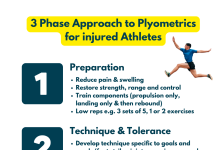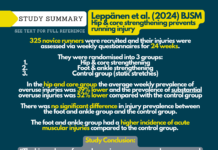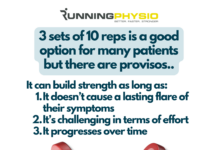Our articles are not designed to replace medical advice. If you have an injury we recommend seeing a qualified health professional. To book an appointment with Tom Goom (AKA ‘The Running Physio’) visit our clinic page. We offer both in-person assessments and online consultations.
I’ve mentioned movement control and balance in most of my blogs on injury management. It’s one of what I think of as the Big Three; Movement control, range of movement and strength. If you have all three you’re onto a winner and less likely to struggle with injury. It’s also likely to improve your running economy, making you run more efficiently with less energy expenditure.
When assessing balance it’s best to start with the basics; single leg balance and single knee dip. When you can manage these, and their variations with ease and good control then you can progress on to more advanced work, including multidirectional exercises and impact control. So let’s start with assessing single leg balance;
[youtube https://www.youtube.com/watch?v=4hIfzfLr3No&w=853&h=505]
Then single knee dip;
[youtube https://www.youtube.com/watch?v=QjysupB1btM&w=853&h=505]
Use a mirror and assess yourself with these 2 tests. If you struggle to maintain balance or to do the dip without excessive trunk, knee or ankle movement then you can rehab this with some of the suggestions in the next videos. To improve single leg balance pick 2 or 3 of the exercises that you find challenging and aim to maintain your balance with good leg alignment for 10-20 seconds. Repeat roughly 10-15 times or stop if you start to fatigue and lose movement control.
[youtube https://www.youtube.com/watch?v=r_rme_6Dpo8&w=853&h=505]
If you struggle with single knee dip, try some of the following exercises and again focus on good control. This is a dynamic exercise rather than a static one so we aren’t focussing on a hold, rather aiming at 10-15 good quality reps, you can increase or decrease this if you want but it’s usually a good place to start.
[youtube https://www.youtube.com/watch?v=0x-MYBelrsw&w=853&h=505]
If you really struggle with balance you may have a strength or range of movement issue that needs addressing too. For example, it’s very hard to balance with very weak glutes or if your ankle range of movement is limited. In the third video note how much my ankle has to move initially when I use the rockerboard on 1 leg, without that flexibility the ankle can’t change position to help maintain balance.
People may point out that these 2 exercises are a little basic and they’re right. There are a lot more advanced control exercises that challenge in multiple directions and at higher speed but a good grounding of basic balance and movement control is needed before progressing to these.










[…] Poor movement control – poor movement control and overpronation go hand in hand. Lack of control at the hip, knee and ankle can all play a part. Assess your single leg balance and single knee dip. Look for the hip adducting (moving towards the other leg) or the ankle rolling in. If you see a control problem try and slow the movement down and do it as an exercise. You may need some support at first until your control improves. Details on improving your movement control are here. […]
[…] like gentle squats or wobble board balance and progress to single leg work balance work (detailed here). Use as much or as little support as you can manage, your aim is restore balance without causing […]
[…] Improving balance and control of movement – in particular preventing excessive hip extension or sideways movements. Details on rehabbing balance here. […]
[…] Have a look at you single leg balance and single knee dip control. Check for overpronation or hip adduction (moving the thigh inwards towards the other leg) especially during single knee dip. More details on assessment and rehab of control issues here. […]
[…] greater load on the patellofemoral joint. Details on assessing and rehab of control of movement are here. Another issue with PFPS is timing of muscle contraction. A number of EMG studies have shown […]
[…] Check your balance – can you balance on one leg for 10 seconds and keep your pelvis and leg steady? Can you do this with your eyes closed? Try a single knee dip and see if your knee drifts in or if you feel unsteady. Info on how to assess and rehab your balance here. […]
[…] navigation ← Previous Next […]
[…] Poor movement control – again linked with biomechanics, running form and muscle strength, your control of movement will affect how your legs deal with impact. With good movement control the ground reaction force is dissipated throughout the leg (I.e. a number of muscles, tendons, ligaments, bones and joints deal with the impact of running). If movement control is poor this can place greater stress on certain areas. Check your single leg balance and single leg dip and compare left and right. Once you can tolerate impact you can also ask your Physio to assess your impact control – here they will look for excess movement in the ankle, knee, hip or trunk and help identify how to improve your control. More info here on assessment and rehab of balance. […]
[…] Check your single leg balance and single knee dip control. Look out for excessive movement of the trunk, hip or knee. Details of how to do this, and balance exercises to use can be found here. […]
[…] good balance and stability, if you struggle with this then you may need to work on it first – assess and rehab your balance. It may be that trail running will do this for you as long as you don't do too much too soon. […]
[…] For runners I would recommend 2 fairly simple tests used by Kibler (2006) – single leg balance and single knee dip. Both are fairly functional to runners and test both balance and core stability. More details on how to do this in assessment and rehab of balance. […]
I prefer the terms ‘balance’ and ‘movement control’ as opposed to the more common ‘core strength/stability’. Control of movement has more research evidence than just strengthening trunks as most people with pain compensate by bracing their body.
The tests are basic but a good starting point to assess how athletes compensate for pain. I think our neurophysio colleagues have a lot to teach us about control of movement and how we can develop better strategies for rehabilitation.
Hi Steve, thanks for your comments. I agree the use of different terms isn’t that helpful and there is a great deal of overlap.
How would you progress from these exercises to more advanced balance and control work?
I completely agree with the above comment! “Movement control” is a better term than “core stability” in almost every context…
[…] If you find a balance difference work on it. With control work the focus is on quality not quantity there is little point doing hundreds of wobbly single knee dips, it's better to do 5-10 controlled movements. Details here on assessing balance and movement control. […]
Great stuff. Only thing to add is to keep the head up and not look down(I’m forever telling my clients that!)
Admiring the time and effort you put into your blog and detailed
information you provide. It’s nice to come across a blog every once in a while that isn’t the same outdated rehashed material.
Excellent read! I’ve saved your site and I’m adding your
RSS feeds to my Google account.
Feel free to visit my page – Barrett
[…] greater load on the patellofemoral joint. Details on assessing and rehab of control of movement are here. Another issue with PFPS is timing of muscle contraction. A number of EMG studies have shown […]
Comments are closed.